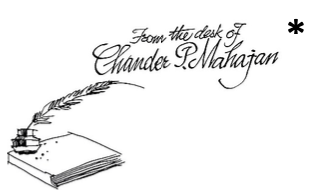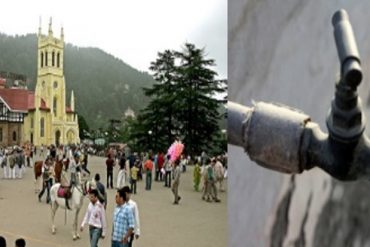The coffee tastes as good as it did five decades ago when I had the first sip at the treat by the fellows & friends.
After joining as an Electrical Engineer with the government of Himachal Pradesh in July 1966; at one time it became a ritual to visit the Coffee House in the morning and in the evening to and fro my office. Unfortunately, the heat of the COVID-19 has slid the ‘Houseful’ status of Shimla’s heritage Indian Coffee House on Mall Road, to the table available’; & further ‘to takeaway and delivery services. The establishment is virtually pulled down to the verge of closure.
Said to be running on a no-profit- no-loss basis, the outlet has sunk into the heaps of liabilities. Hats off to the loyal employees who still carry on with the utmost dedication, in a bleak hope to get their dues.
The Indian Coffee House in Dharamsala (Kangra) that I enjoyed visiting was another popular hang-out in the city till the Indian Coffee Workers’ Co-operative Society closed it down in 2006 owing to heavy losses.
There were nearly 50 Coffee Houses all over British India. Indians were perhaps not allowed into these coffee houses, which were mainly Europeans-only establishments.
- Coffee had been grown in India by native Indians for many hundred years before the concept of coffee houses began; though the expression ‘coffee break’ picked up only in the mid-fifties of the nineteenth century.
- Coffee is a brewed drink prepared from roasted coffee beans. It is ground into a powder and mixed with water to produce a cup of coffee. It is dark-coloured, bitter, slightly acidic and has a stimulating effect on humans, primarily due to its caffeine content.
- The two most commonly grown coffee bean types are Arabica and robusta. The roasting process influences the taste of the beverage by changing the coffee bean both physically and chemically. Depending on the color of the roasted beans as perceived by the human eye, they will be labeled as light, medium-light, medium, medium-dark, dark, or very dark. Coffee “cuppers”, or professional tasters, grade the coffee.
- Whiffing the aroma of freshly ground coffee is my passion. I would like to try out every kind of coffee in the world.
- kopiluwak, one of the world’s most expensive coffee, is made from coffee beans that are partially digested and then pooped out by the civet, a catlike creature. It is said to have a uniquely rich, slightly smoky aroma and flavor with hints of chocolate.
- In Thailand, black ivory coffee beans are fed to elephants whose digestive enzymes reduce the bitter taste of beans collected from dung. This coffee is costlier than even kopi luwak.
- In India, we have a variety of our own.
- In Yanam, Puducherry, while I worked as a Professor in RIT, I got more into the taste of South Indian Filter Coffee; and today that is my favourite brew. The frothy blend of coffee decoction, hot milk and sugar to taste, served in a steel cup.
- Jaggery black Coffee (Bella Kaapi) has a perfect balance of bitterness from the coffee decoction and sweetness and a smoky taste from the jaggery. Adding cardamom, ginger, and cinnamon is another choice.
- Karupatti Coffee is prepared with coffee decoction, water and palm jaggery, & is healthier compared to sugarcane jaggery.
- The Tandoori Coffee is poured into the extremely hot kulhad (clay pot) from a pre-heated tandoor to let the drink bubble over as it finishes cooking, lending coffee a strong smoky flavour.
- Indian Hand Beaten Coffee (the Desi Cappuccino) is a home whipped concoction. The bitter-sweet frothy mixture is poured into a glass filled with hot or cold milk. It finds favour with both Manu Maharaaj and Meenakshi. ‘Phenti hui coffee’ is always at home when they are around.
- The roasted coffee beans can be ground at home immediately before consumption.
- A well-prepared espresso has a reddish-brown foam called crema that floats on the surface.
- Once brewed, coffee may be served as white coffee with milk or cream, or as black coffee with no such addition. When served cold, it is called iced coffee.
- How excited the goats of an Ethiopian goatherd became after eating beans from a coffee plant is an anecdote from the ninth century.
- ‘To lack hunger’, in reference to the drink’s reputation as an appetite suppressant, Coffee was used in Sufi circles to stay awake for their religious rituals.
- Coffee can also be blended with alcohol to produce a variety of beverages: it is combined with whiskey in Irish coffee, and it forms the base of alcoholic coffee liqueurs such as ‘Kahlúa’ and ‘Tia Maria’.
- Instant coffee has been gaining popularity with Nescafe’ being the most popular product as if it is similar to the taste of freshly brewed coffee or percolated coffee, available both hot and cold.
Coffee production consumes a large volume of water. On average it takes about 140 liters of water to grow the coffee beans needed to produce one cup of coffee. Climate change may significantly impact coffee yields during the 21st century. The coffee industry’s negative impact on the environment and the clearing of land for coffee-growing and water use cannot be overlooked.
A lingering flavour of caffeine keeps going into my nostrils. I wonder if I am a coffee addict.
According to ‘Neuroscience News.com’ high caffeine consumption may increase the risk of Blinding Eye Disease.
…………………………………………………………………………………………………………………………..
Prof. (Er.) Chander P Mahajan is an art critic & a free lance journalist. The Environmentalist stays in Shimla and Dalhousie, Himachal Pradesh, India.







